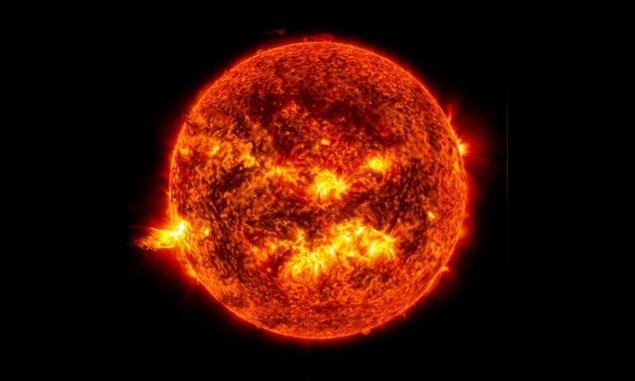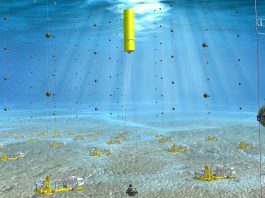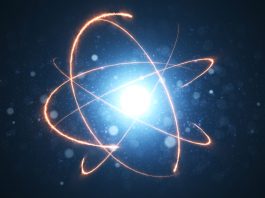Scientists working on the Borexino neutrino detector in Italy have shown that simultaneous measurements of low-energy solar neutrinos are possible.
Physicists measuring the properties of solar neutrinos have had to make a compromise – either measure the particles’ energy with high precision and sacrifice the directional information, or pin down the direction and settle for inferior energy resolution.
However, scientists working on the Borexino neutrino detector have shown it is possible to determine both measurements simultaneously. This can be achieved by exploiting the known position of the Sun at any time, in order to work out the trajectory of electrons scattered by incoming low-energy neutrinos.
The new technique paves the way for hybrid measurements that could yield fresh insights into the workings of the Sun and nuclear physics more broadly, said researchers.
The research has been published in both Physical Review Letters and Physical Review D.
Why are physicists measuring low-energy solar neutrinos?
Solar neutrinos are created during the fusion reactions that generate the Sun’s immense heat, and their detection on Earth provides knowledge regarding the different stages of those reactions. Therefore, this data reveals the relative importance of different fusion pathways for forging heavier elements from hydrogen.
Additionally, these observations can also help to better understand the basic physics of nuclear decay and of neutrinos themselves.
What has observation of Borexino revealed?
The Borexino neutrino detector has been at the forefront of low-energy solar neutrino research over the last 15 years. It has measured neutrino fluxes from different branches of the proton-proton chain, and more recently from the previously elusive carbon–nitrogen–oxygen – cycle, both of which convert hydrogen into helium in the Sun.
This is done by utilising a detector that is located at the Gran Sasso National Laboratory, 1,400 metres beneath a mountain in Central Italy. Currently being dismantled, that detector consisted of 280 tonnes of an extremely radio-pure liquid scintillator, which was shielded by a layer of water inside a large cylindrical tank.
The detection scheme relied on picking up the tiny signals generated when incoming low-energy solar neutrinos scattered off electrons within the scintillator. More specifically, it detected the light given off by the scintillator molecules when excited by the recoiling electrons.
What does the scintillation light indicate about neutrinos?
The scintillation light was emitted in all directions, which was easy for scientists to discern via the hundreds of photomultiplier tubes (PMTs) that lined the inside of the detector. This meant that Borexino could measure the low-energy solar neutrino energies at high resolution and at quite low energy thresholds.
However, this isotropic emission provides no information regarding the scattered electrons’ trajectories, which is vital for suppressing (isotropic) background interference, as well as distinguishing between the different types of recoil particles.
How was this information analysed?
Such directional information is the specialty of Cherenkov detectors, such as the Super-Kamiokande facility in Japan. These utilise vast quantities of extremely pure water as their detecting medium, which measures the Cherenkov radiation given off when a recoiling electron travels faster than the speed of light in water.
That light is emitted in a cone around the electron’s direction of travel and can therefore be employed to work out the particle’s trajectory. However, Cherenkov’s emission only occurs for electrons above a minimum kinetic energy, which is dictated by the medium’s refractive index.
Thus, for water, the required energy is 0.25 MeV. In practice, however, the finite coverage and efficiency of the PMTs, combined with the distorting effects of background radiation, leads to a low-energy solar neutrino detection threshold of around 3.5 MeV.
Borexino physicists have now revealed that it is possible to lower this threshold by correlating the Cherenkov photons with the Sun’s known position at any point. This relies on the fact that incoming low-energy solar neutrinos tend to scatter electrons along a very similar path to their own. As such, the ensuing radiation is picked up by PMTs fairly close to the solar-detector axis.
Thus, this implies that the Cherenkov photons can, in principle, be distinguished from background radiation, which, like the scintillation photons, is not correlated with the Sun’s position.
What issues may be encountered?
A concern that scientists have come across is that these Cherenkov photons are too few and far between to generate any measurable signal above the noise. Also, the Borexino researchers calculated it might be possible to pick them out by associating them with the numerous scintillation photons generated several nanoseconds later.
Furthermore, the low signal-to-noise ratio means that individual Cherenkov events cannot be picked up, so multiple data points need to be collected and utilised to plot a graph portraying the angle that the early arriving photons make with the solar axis. The signature of Cherenkov photons would then be a peak in the angular distribution close to the forward direction.
That is what Borexino researchers discovered when re-analysing old Borexino data, whose calibration allowed for an accurate analysis of the expected Cherenkov light. Restricting their analysis to the energy range 0.54–0.74 MeV, they encountered a peak among the 19,904 data points.
They then employed a computer simulation to separate the low-energy solar neutrino events from the background and concluded that the real events number was 10,887. This implies a statistical certainty, just above the 5σ discovery threshold, that they have detected Cherenkov photons.
What does this mean for future applications?
Having directional information at low energies should in principle allow for detailed scrutiny of the Sun’s carbon–nitrogen–oxygen cycle, noted researchers. Therefore, it should also improve searches for a very rare nuclear process in the detector known as ‘neutrinoless double beta decay,’ because solar neutrinos constitute a source of background in the search.
Additionally, the results are described as a ‘proof of principle’ demonstration of hybrid Cherenkov-scintillation event detection, as scientists have noted that their measurement contains quite large statistical and systematic uncertainties.
However, it is believed that it should still be possible to achieve greater sensitivities by utilising better adapted PMTs and electronics, as well as perhaps a different scintillator material.
Gabriel Orebi Gann of the University of California, Berkeley, who was not involved with the research, argued that the latest work represents ‘a critical development’ in low-energy solar neutrino detection technology. She agrees that more needs to be done to reap the full benefits of such hybrid detection – for example, being able to establish recoil direction on an event-by-event basis rather than through statistical reconstruction. If that can be done, she said, then a broad range of applications stand to gain – from solar physics to nuclear non-proliferation monitoring.
To keep up to date with our content, subscribe for updates on our digital publication and newsletter.









